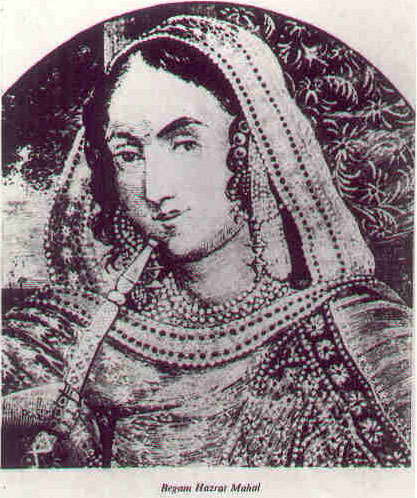
| Home | Index | email: oudh@rediffmail.com |

|
|
From the date of the Sepoy victory (July 30, 1857) at Chinhut near Lucknow till the last phase of the rebellion of 1857-58, the revolutionary history of Oudh was overshadowed by a woman who was in no respect less illustrious than the Rani Lakshmi Bai of Jhansi. She was Hazrat Mahal, a begam of the deposed King Wazid Ali Shah. After the victory at Chinhut, when the revolutionary forces captured the city of Lucknow, leaving only the Residency, terror and oppression was let loose. The leaders felt the necessity to try out a royal symbol to take control, under whose banner diverse interests could be united. In that troubled hour the royal insignia was borne with amazing courage by the Begam, by crowning her minor son, Birjis Kadar, as King, herself acting as Regent. Hazrat Mahal's rise to position of power was from a rather ill-favoured beginning. Little is still known about her enigmatic career and origin. She probably hailed from Faizabad, born of a very poor family. Unlike Rani Lakshmi Bai of Jhansi, the Begam had a different beginning to her career. She was born at a time and brought up in a manner suitable only for a life of gay abandon. Her obvious place was in the royal harem of an extraordinary King, essentially a poet par excellence and a connoisseur of beauty. William Howard Russell in his My Indian Mutiny Diary writes: "the Sepoys, during the siege of the Residency, never came on as boldly as the zamindari levies and nujeebs (irregulars), This Begam exhibits great energy and ability. She has e3xcited all Oudh to take up the interests of her son, and the chiefs have sworn to be faithful to him. Will the Government treat these men as rebels or as honourable enemies? The Begum declares undying war against us. It appears, from the energetic character of these Ranis and Begums, that they zenanas and harems a considerable amount of actual mental power and, at all events, become able intriguantes. Their contests for ascendancy over the minds of the men give vigour and acuteness to their intellect." A BOY KING The Begam headed a Government, with top revolutionary leaders in key positions, under whose banner the different sections of the soldiery assembled to form a united front. For about six months the revolutionary Government held the city of Lucknow under its control and invested the Residency continuously for twelve and half weeks. During all these operations the Begam was obviously the supreme commander. Under the seal of King Birjis Qadar she issued proclamations to the people in general, and to the zamindars and taluqdars of Oudh in particular, to unite under the banner of the new Government to fight the English. It is understood she even toured the province to stir up feeling against foreign rule. She was indirect correspondence with Nana Saheb and with some of the noble and time-honoured taluqdar and zamindar families, who actively participated in the investiture of the Residency and later in the battles of Lucknow. Among her important associates were Rana Beni Madho Baksh of Baiswara, Raja Drig Bijai Singh of Mahona, Khan Ali Khan of Shahjehanpur, Maulvi Ahmad Ullah Shah of Faizabad, Raja Man Singh and Raja Jayelal Singh, to name only a few. COUNTER-OFFER After the capture of Lucknow the Begam was listed by the English as No.1 of the enemies still at large. From Lucknow she retired with a large following across the River Ghagra and posted herself in the fort of Baundi, in Bahraich district. She fortified the stronghold with heavy guns and armed men. A correspondent of the Government reported: "….a force is encamped on all sides of the fort, numbering about 15,000 or 16,000 including followers. Among these there are 1,500 cavalry and 500 mutineer sepoys, the rest are nujeebs and followers." HARD FIGHTING After the Queen's Proclamation, the English wanted to win her over by offers of royal clemency and even of a pension. The spirited lady replied with a counter-proclamation under the seal of King Birjis Qadar, warning the people of Oudh not to be misled by false promises. The Begam's Proclamation, as it is called, stated: "At this time certain weak-minded, foolish people, have spread a report that the English have forgiven the faults and crimes of the people of Hindoostan. This appears very astonishing, for it is the unvarying custom of the English never to forgive a fault, be it great or small so much so, that if a small offence be committed through ignorance or negligence, they never forgive it….. therefore we, the ever-abiding government, parents of the people of Oude, with great cosideration, put forth the present proclamation, in order that the real object of the chief points may be exposed, and our subjects placed on their guard." Vanquished though she was, the Begam remained faithful to her cause to the last and maintained a never-failing resolution of purpose. She was determinded not to fall into the hands of the English; and leaving the fort of Baundi in December, 1858, she wandered in the dense jungle of the sub-Himalayan terai with a handful of faithful soldiers, "half-armed, half-fed and without artillery." Eluding the English. She ultimately crossed over to Nepal (some time in the last quarter of 1859), where she was given refuge by the King despite English protests. The Begam is stated to have died in 1874 at Kathmandu, where she lived with her son as a commoner. |
| Home | Index | email: oudh@rediffmail.com |